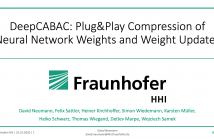
There is growing interest in the use of deep neural network
(DNN) based image denoising to reduce patient’s X-ray
dosage in medical computed tomography (CT). An effective
denoiser must remove noise while maintaining the texture
and detail. Commonly used mean squared error (MSE) loss
functions in the DNN training weight errors due to bias and
variance equally. However, the error due to bias is often more
egregious since it results in loss of image texture and detail.
In this paper, we present a novel approach to designing a loss
- Categories:
 58 Views
58 Views
- Read more about Presentation Slides: SPARSITY DRIVEN LATENT SPACE SAMPLING FOR GENERATIVE PRIOR BASED COMPRESSIVE SENSING
- 1 comment
- Log in to post comments
- Categories:
 10 Views
10 Views
- Read more about Poster : SPARSITY DRIVEN LATENT SPACE SAMPLING FOR GENERATIVE PRIOR BASED COMPRESSIVE SENSING
- 1 comment
- Log in to post comments
- Categories:
 15 Views
15 Views
- Read more about Presentation Slides: SPARSITY DRIVEN LATENT SPACE SAMPLING FOR GENERATIVE PRIOR BASED COMPRESSIVE SENSING
- Log in to post comments
- Categories:
 3 Views
3 Views
- Read more about Two-Stage Framework for Seasonal Time Series Forecasting (ICASSP 2021 Slides)
- Log in to post comments
- Categories:
 23 Views
23 Views
- Read more about Two-Stage Framework for Seasonal Time Series Forecasting (ICASSP 2021 Poster)
- Log in to post comments
- Categories:
 4 Views
4 Views
Network data can be conveniently modeled as a graph signal, where data values are assigned to the nodes of a graph describing the underlying network topology. Successful learning from network data requires methods that effectively exploit this graph structure. Graph neural networks (GNNs) provide one such method and have exhibited promising performance on a wide range of problems. Understanding why GNNs work is of paramount importance, particularly in applications involving physical networks.
- Categories:
 8 Views
8 Views
- Read more about SIG2SIG : SIGNAL TRANSLATION NETWORKS TO TAKE THE REMAINS OF THE PAST
- Log in to post comments
- Categories:
 16 Views
16 Views
- Read more about Pipeline Safety Early Warning Method for Distributed Signal using Bilinear CNN and Lightgbm
- Log in to post comments
- Categories:
 33 Views
33 Views
- Read more about DeepCABAC - Plug&Play Compression of Neural Network Weights and Weight Updates
- Log in to post comments
An increasing number of distributed machine learning applications require efficient communication of neural network parameterizations. DeepCABAC, an algorithm in the current working draft of the emerging MPEG-7 part 17 standard for compression of neural networks for multimedia content description and analysis, has demonstrated high compression gains for a variety of neural network models. In this paper we propose a method for employing DeepCABAC in a Federated Learning scenario for the exchange of intermediate differential parameterizations.
- Categories:
 70 Views
70 Views